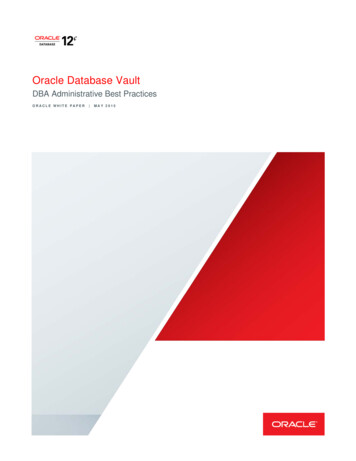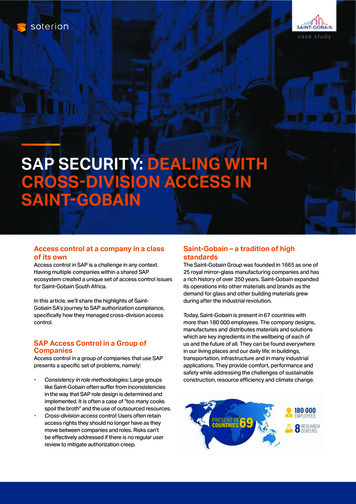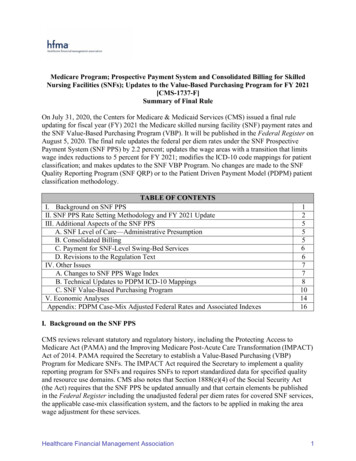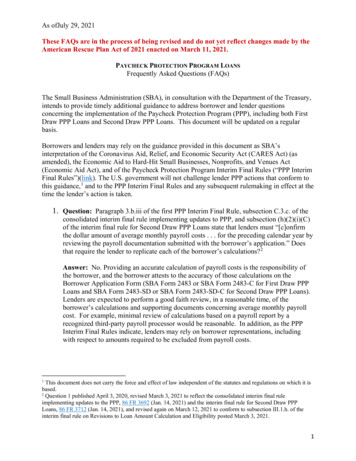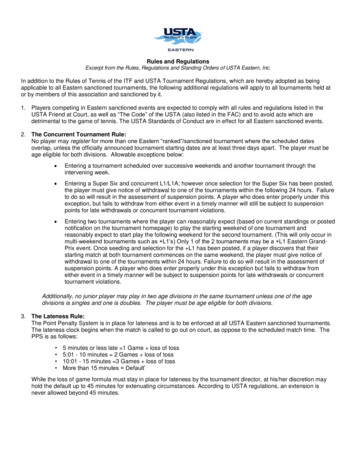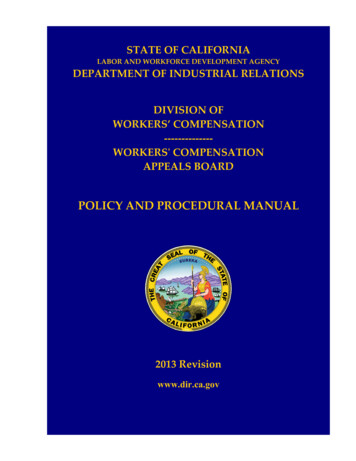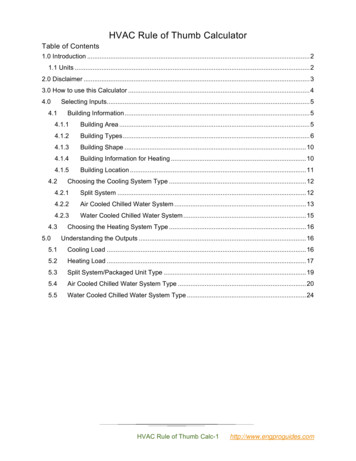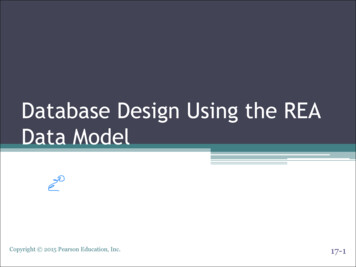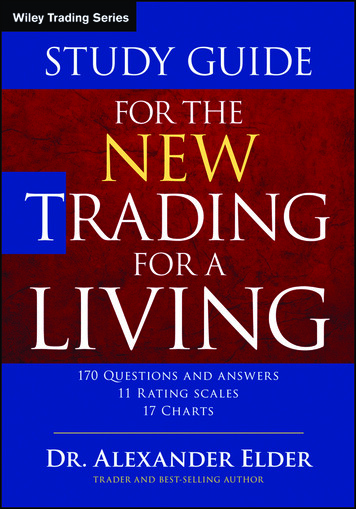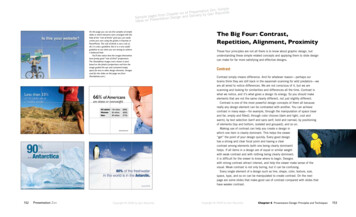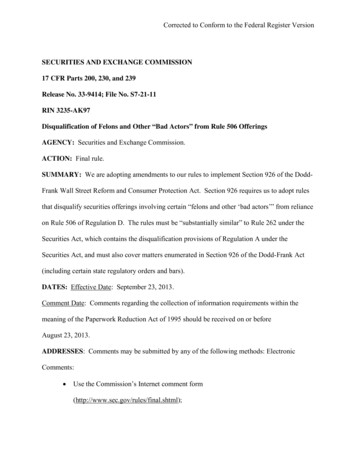
Transcription
Corrected to Conform to the Federal Register VersionSECURITIES AND EXCHANGE COMMISSION17 CFR Parts 200, 230, and 239Release No. 33-9414; File No. S7-21-11RIN 3235-AK97Disqualification of Felons and Other “Bad Actors” from Rule 506 OfferingsAGENCY: Securities and Exchange Commission.ACTION: Final rule.SUMMARY: We are adopting amendments to our rules to implement Section 926 of the DoddFrank Wall Street Reform and Consumer Protection Act. Section 926 requires us to adopt rulesthat disqualify securities offerings involving certain “felons and other ‘bad actors’” from relianceon Rule 506 of Regulation D. The rules must be “substantially similar” to Rule 262 under theSecurities Act, which contains the disqualification provisions of Regulation A under theSecurities Act, and must also cover matters enumerated in Section 926 of the Dodd-Frank Act(including certain state regulatory orders and bars).DATES: Effective Date: September 23, 2013.Comment Date: Comments regarding the collection of information requirements within themeaning of the Paperwork Reduction Act of 1995 should be received on or beforeAugust 23, 2013.ADDRESSES: Comments may be submitted by any of the following methods: ElectronicComments: Use the Commission’s Internet comment form(http://www.sec.gov/rules/final.shtml);
Send an e-mail to rule-comments@sec.gov. Please include File Number S7-21-11 on the subject line; or Use the Federal eRulemaking Portal (http://www.regulations.gov). Follow theinstructions for submitting comments.Paper Comments: Send paper comments on the Paperwork Reduction Act analysis in triplicate toElizabeth M. Murphy, Secretary, Securities and Exchange Commission, 100 F Street,NE, Washington, DC 20549-1090.All submissions should refer to File Number S7-21-11. This file number should be included onthe subject line if e-mail is used. To help us process and review your comments more efficiently,please use only one method. The Commission will post all comments on the Commission’sInternet website (http://www.sec.gov/rules/final.shtml). Comments will also be available forwebsite viewing and printing in the Commission’s Public Reference Room, 100 F Street, NE,Washington, DC 20549, on official business days between the hours of 10:00 a.m. and 3:00 p.m.All comments received will be posted without change; we do not edit personal identifyinginformation from submissions. You should submit only information that you wish to makeavailable publicly.FOR FURTHER INFORMATION CONTACT: Johanna Vega Losert, Special Counsel,Karen C. Wiedemann, Attorney Fellow, or Gerald J. Laporte, Office Chief, Office of SmallBusiness Policy, Division of Corporation Finance, at (202) 551-3460, Securities and ExchangeCommission, 100 F Street, NE, Washington, DC 20549-3628.2
SUPPLEMENTARY INFORMATION: We are adopting amendments to Rules 145, 1 147, 2152 3 and 155; 4 Rules 501 5 and 506 6 of Regulation D; 7 and Form D 8 under the Securities Act of1933 9 and to Rule 30-1 10 of our Rules of Organization and Program Management.TABLE OF CONTENTSI.BACKGROUND AND SUMMARYII.DISCUSSION OF THE FINAL AMENDMENTSA.IntroductionB.Covered PersonsC.Disqualifying Events1.Criminal Convictions2.Court Injunctions and Restraining Orders3.Final Orders of Certain Regulators4.Commission Disciplinary Orders5.Certain Commission Cease-and-Desist Orders6.Suspension or Expulsion from SRO Membership or Association with anSRO Member7.Stop Orders and Orders Suspending the Regulation A Exemption8.U.S. Postal Service False Representation OrdersD.Reasonable Care Exception1.Reasonable Care Standard2.Continuous and Long-Lived OfferingsE.Waivers1.Waiver for Good Cause Shown2.Waiver Based on Determination of Issuing AuthorityF.Transition Issues117 CFR 230.145.217 CFR 230.147.317 CFR 230.152.417 CFR 230.155.517 CFR 230.501.617 CFR 230.506.717 CFR 230.500 through 230.508.817 CFR 239.500.915 U.S.C. 77a et seq.1017 CFR 200.30-1.3
1.G.Disqualification Applies Only to Triggering Events That Occur AfterEffectiveness of the Rule Amendments2.Mandatory Disclosure of Triggering Events That Pre-Date Effectivenessof the Rule3.Timing of ImplementationAmendment to Form DIII.PAPERWORK REDUCTION ACTA.BackgroundB.Burden and Cost Estimates Related to the Adopted AmendmentsIV.ECONOMIC ANALYSISA.Background and Summary of the Rule AmendmentsB.Economic Baseline1.Capital Raising Activity Using Rule 5062.Affected Market ParticipantsA.IssuersB.InvestorsC.Investment ManagersD.Broker-Dealers3.Estimated Incidence of “Bad Actors” in Securities Markets GenerallyC.Analysis of Final Rules1.Effects of the Statutory Mandate2.Discretionary AmendmentsV.FINAL REGULATORY FLEXIBILITY ACT ANALYSISA.Reasons for, and Objectives of, the ActionB.Significant Issues Raised By Public CommentsC.Small Entities Subject to the Rule AmendmentsD.Reporting, Recordkeeping and Other Compliance RequirementsE.Duplicative, Overlapping or Conflicting Federal RulesF.Significant AlternativesVI.STATUTORY AUTHORITY AND TEXT OF AMENDMENTS4
I.BACKGROUND AND SUMMARYSection 926 of the Dodd-Frank Wall Street Reform and Consumer Protection Act (the“Dodd-Frank Act”), entitled “Disqualifying felons and other ‘bad actors’ from Regulation Dofferings,” requires the Commission to adopt rules to disqualify certain securities offerings fromreliance on Rule 506 of Regulation D. 11 The Commission proposed rule amendments toimplement Section 926 of the Dodd-Frank Act on May 25, 2011. 12 Today we are adoptingamendments to Rules 501 and 506 and to Form D to implement Section 926. Thedisqualification provisions we are adopting, to be codified as new paragraph (d) of Rule 506, 13are generally consistent with the proposal, but will apply only to triggering events occurring aftereffectiveness of the rule amendments (with pre-existing events subject to mandatory disclosure)and also reflect some changes in response to comments.Rule 506 is one of three exemptive rules for limited offerings under Regulation D. 14 It isby far the most widely used Regulation D exemption, accounting for an estimated 90% to 95%11Pub. L. No. 111-203, sec. 926, 124 Stat. 1376, 1851 (July 21, 2010) (codified at 15 U.S.C. 77d note).12See Disqualification of Felons and Other “Bad Actors” from Rule 506 Offerings, Release No. 33-9211 (May 25,2011) [76 FR 31518 (June 1, 2011)].13Because of the adoption of new Rule 506(c), the disqualification provisions we adopt today, which wereproposed as Rule 506(c), will be adopted and codified as Rule 506(d).14The others are Rule 504 and Rule 505, 17 CFR 230.504 and 230.505. Rule 504 permits offerings of up to 1million of securities by issuers that are not (i) reporting companies under the Securities Exchange Act of 1934, (ii)investment companies or (iii) development stage companies with no specific business plan or purpose, or whosebusiness plan is to engage in a merger or acquisition with an unidentified entity or entities. Offerings underRule 504 must generally comply with Regulation D requirements regarding limitations on manner of sale (nogeneral solicitation) and limitations on resale. The manner of sale and resale limitations do not apply, however, toofferings that are subject to state-level registration or that rely on state law exemptions permitting generalsolicitation so long as sales are made only to accredited investors. Rule 505 permits offerings of up to 5 million ofsecurities annually, without general solicitation, to an unlimited number of accredited investors and up to 35 nonaccredited investors. Rule 505 offerings are subject to the same conditions as apply to Rule 506 offerings, which aredescribed elsewhere, except that non-accredited investors are not required to be sophisticated and such offerings aresubject to bad actor disqualification provisions.5
of all Regulation D offerings 15 and the overwhelming majority of capital raised in transactionsunder Regulation D. 16 Rule 506 permits sales of an unlimited dollar amount of securities to bemade without Securities Act registration, provided that the requirements of the rule are satisfied.Rule 506 historically has permitted sales to an unlimited number of accredited investors 17and up to 35 non-accredited investors, so long as there was no general solicitation, appropriateresale limitations were imposed, any applicable information requirements were satisfied, and theother conditions of the rule were met. 18 Section 201(a) of the Jumpstart Our Business StartupsAct (“JOBS Act”) required the Commission to eliminate the prohibition against generalsolicitation and general advertising for offers and sales of securities made pursuant to Rule 506,provided that all purchasers of the securities are accredited investors and the issuer takes15In 2012, the Commission received 18,187 initial filings for offerings under Regulation D, of which 17,203(approximately 95%) claimed a Rule 506 exemption.16Staff of the Commission’s Division of Economic and Risk Analysis estimates that, for 2009, 2010, 2011 and2012, approximately 607 billion, 1.003 trillion, 850 billion and 899 billion, respectively, was raised intransactions claiming the Rule 506 exemption, in each case representing more than 99% of funds raised underRegulation D for the period, based on Form D filings with the Commission. The amount of capital raised throughofferings under Regulation D and the number of Regulation D offerings may be considerably larger than what isdisclosed in Form D filings because the filing of a Form D notice is a requirement of Rule 503(a) of Regulation D[17 CFR 230.503(a)], but is not a condition to the availability of the exemptions of Regulation D. We understandthat some issuers, therefore, may not make Form D filings for offerings made in reliance on Regulation D. Further,once a Form D filing is made, the issuer is not required to file an amendment to reflect a change that occurs after theoffering terminates or a change that occurs solely with respect to certain information, such as the amount sold in theoffering. For example, if the amount sold does not exceed the offering size by more than 10% or the offering closesbefore a year has passed, the filing of an amendment to Form D would not necessarily be required. Therefore, theForm D filings for an offering may not reflect the total amount of securities sold in the offering in reliance on theexemption.17Rule 501 of Regulation D lists eight categories of “accredited investor,” including entities and natural personsthat meet specified income or asset thresholds. See 17 CFR 230.501.18Except as provided under new Rule 506(c), offerings under Rule 506 are subject to all the terms and conditions ofRules 501 and 502, including applicable limitations on the manner of offering, limitations on resale and, if securitiesare sold to any non-accredited investors, specified information requirements. Where securities are sold only toaccredited investors, the information requirements do not apply. See 17 CFR 230.502 and 230.506. In addition, anynon-accredited investors must satisfy the investor sophistication requirements of Rule 506(b)(2)(ii). Offerings underRule 506 must also comply with the notice of sale requirements of Rule 503. See 17 CFR 230.503.6
reasonable steps to verify their accredited investor status. 19 In a separate release today, we areadopting amendments to Rule 506 and Form D, including adding new paragraph (c) to Rule 506to implement JOBS Act Section 201(a). 20 As a result, offers and sales of securities involving theuse of general solicitation will be permitted under Rule 506, provided that the requirements ofnew Rule 506(c) are satisfied.“Bad actor” disqualification requirements, sometimes called “bad boy” provisions,disqualify securities offerings from reliance on exemptions if the issuer or other relevant persons(such as underwriters, placement agents and the directors, officers and significant shareholders ofthe issuer) have been convicted of, or are subject to court or administrative sanctions for,securities fraud or other violations of specified laws. Rule 506 in its current form does notimpose any bad actor disqualification requirements. 21 In addition, because securities sold underRule 506 are “covered securities” under Section 18(b)(4)(D) of the Securities Act, state-level badactor disqualification rules do not apply. 2219See Pub. L. No. 112-106, sec. 201(a), 126 Stat. 306, 313 (Apr. 5, 2012).20Eliminating the Prohibition Against General Solicitation and General Advertising in Rule 506 and Rule 144AOfferings, Release No. 33-9415 (July 10, 2013).21Rule 507 of Regulation D imposes a different kind of disqualification specific to Regulation D offerings. UnderRule 507, any person that is subject to a court order, judgment or decree enjoining such person for failure to file thenotice of sale on Form D required under Rule 503 is disqualified from relying on Regulation D. 17 CFR 230.507(a).We are not amending Rule 507 at this time but, in a separate release the Commission is issuing today, we areproposing amendments to Rule 507 that would disqualify an issuer from reliance on Rule 506 if the issuer or itspredecessor or affiliates had conducted a previous securities offering in reliance on Rule 506 without complyingwith the Form D filing requirements of Rule 503. See Amendments to Regulation D, Form D, and Rule 156,Release No. 33-9416 (July 10, 2013).22See 15 U.S.C. 77r(b)(4)(D). This provision of Section 18 was added by Section 102(a) of the National SecuritiesMarkets Improvement Act of 1996, Pub. L. No. 104-290,110 Stat. 3416 (Oct. 11, 1996) (“NSMIA”). NSMIApreempts state registration and review requirements for transactions involving “covered securities,” which includesecurities offered or sold in transactions that are exempt from registration under Commission rules or regulationsissued under Securities Act Section 4(a)(2) (formerly Section 4(2)). Rule 506 was originally adopted as a safeharbor under Section 4(a)(2). Section 201(a) of the JOBS Act provides that Rule 506, as amended in accordancewith the mandate of that provision, “shall continue to be treated as a regulation issued under” Section 4(a)(2) of theSecurities Act.7
Section 926 of the Dodd-Frank Act instructs the Commission to issue disqualificationrules for Rule 506 offerings that are “substantially similar” to the bad actor disqualificationprovisions contained in Rule 262 of Regulation A, 23 and also provides an expanded list ofdisqualifying events, including certain actions by state regulators, enumerated in Section 926.The disqualifying events listed in Rule 262 cover the issuer and certain other persons associatedwith the issuer or the offering, including: issuer predecessors and affiliated issuers; directors,officers and general partners of the issuer; beneficial owners of 10% or more of any class of theissuer’s equity securities; promoters connected with the issuer; and underwriters and theirdirectors, officers and partners. Rule 262 disqualifying events include: Felony and misdemeanor convictions in connection with the purchase or sale of asecurity or involving the making of a false filing with the Commission (the samecriminal conviction standard as in Section 926 of the Dodd-Frank Act) within the lastfive years in the case of issuers and ten years in the case of other covered persons; Injunctions and court orders within the last five years against engaging in orcontinuing conduct or practices in connection with the purchase or sale of securities,or involving the making of any false filing with the Commission; U.S. Postal Service false representation orders within the last five years; Filing, or being named as an underwriter in, a registration statement or Regulation Aoffering statement that is the subject of a proceeding to determine whether a stop2317 CFR 230.262. Regulation A (17 CFR 230.251 through 230.263) is a limited offering exemption that permitspublic offerings of securities not exceeding 5 million in any 12-month period by companies that are not required tofile periodic reports with the Commission. Regulation A offerings are required to have an offering circularcontaining specified information, which is filed with the Commission and subject to review by the staff of theDivision of Corporation Finance.8
order should be issued, or as to which a stop order was issued within the last fiveyears; and For covered persons other than the issuer:o being subject to a Commission order: revoking or suspending their registration as a broker, dealer, municipalsecurities dealer, or investment adviser; placing limitations on their activities as such; barring them from association with any entity; or barring them from participating in an offering of penny stock; oro being suspended or expelled from membership in, or suspended or barred fromassociation with a member of, a registered national securities exchange or nationalsecurities association for conduct inconsistent with just and equitable principles oftrade.The disqualifying events specifically required by Section 926 are: Final orders issued by state securities, banking, credit union, and insurance regulators,federal banking regulators, and the National Credit Union Administration that eithero bar a person from association with an entity regulated by the regulator issuing theorder, or from engaging in the business of securities, insurance or banking, orfrom savings association or credit union activities; oro are based on a violation of any law or regulation that prohibits fraudulent,manipulative, or deceptive conduct within a ten-year period; and Felony and misdemeanor convictions in connection with the purchase or sale of asecurity or involving the making of a false filing with the Commission.9
On May 25, 2011, we proposed amendments to Rules 501 and 506 of Regulation D andForm D to implement Section 926. 24 We received 44 comment letters in response to ourproposal. 25 In addition, we received three advance comment letters commenting on Section 926before the publication of the proposing release. 26 These comment letters and advance commentletters came from a variety of individuals, groups and constituencies, including state securitiesregulators, professional and trade associations, lawyers, academics and individual investors.Most commenters expressed general support for the proposed amendments and the objectivesthat we articulated in the proposing release, but many suggested modifications to the proposals.Today we are adopting amendments to Rules 501 and 506 of Regulation D and toForm D to implement Section 926 of the Dodd-Frank Act. 27 The amendments we are adoptingare generally consistent with the proposal, with the following principal differences: disqualification will apply only for triggering events that occur after the effective dateof the amendments; however, pre-existing matters will be subject to mandatorydisclosure;24See Disqualification of Felons and Other “Bad Actors” from Rule 506 Offerings, Release No. 33-9211 (May 25,2011) [76 FR 31518 (June 1, 2011)].25The comment letters we received on the proposal are available on our website l. In this release, we refer to these letters as the “commentletters” to differentiate them from the “advance comment letters” described in note 26.26To facilitate public input on its Dodd-Frank Act rulemaking before issuance of rule proposals, the Commissionprovided a series of e-mail links, organized by topic, on its website html. In this release, we refer to comment letters we received onthis rulemaking project in response to this invitation as “advance comment letters.” These advance comment lettersappear on the Commission’s website under the heading “Adding Disqualification Requirements to Regulation DOfferings, Title IX Provisions of the Dodd-Frank Wall Street Reform and Consumer Protection Act.”27We are also adopting technical amendments to Rules 145, 147, 152 and 155 to update references to Section 4(2)of the Securities Act, which was renumbered as Section 4(a)(2) by Section 201(c) of the JOBS Act, Pub. L. No. 112106, sec. 201(c), 126 Stat. 306, 314 (Apr. 5, 2012).10
the rule includes additional disqualifying events for certain orders of the CommodityFutures Trading Commission (“CFTC”) and for Commission cease-and-desist ordersarising out of scienter-based anti-fraud violations and violations of Section 5 of theSecurities Act; instead of covering all officers of the issuer and of any compensated solicitors ofpurchasers of securities, the rule is limited to executive officers and officers whoparticipate in the offering; rather than covering beneficial owners of 10% or more of any class of the issuer’ssecurities, the rule covers beneficial owners of 20% or more of the issuer’soutstanding voting equity securities, calculated on the basis of voting power; for issuers that are pooled investment funds, the rule covers the funds’ investmentmanagers and their principals; and disqualification will not apply if the authority issuing the relevant judgment, order orother triggering directive or statement determines and advises the Commission thatdisqualification from reliance on Rule 506 should not arise as a result.Part III of the proposing release requested comment on a number of potential further ruleamendments that would result in more uniform bad actor disqualification rules, including theapplication of the new bad actor disqualification standards to offerings under Regulation A,Regulation E and Rules 504 and 505 of Regulation D. Commenters were divided in their viewswith respect to uniform bad actor standards. Some commenters supported uniformity on thebasis that it would enhance investor protection, increase clarity and consistency in our11
regulations and avoid the creation of opportunities for regulatory arbitrage. 28 Others opposed it,generally arguing that attempts to impose uniformity would be premature or inappropriate giventhe limits of the Dodd-Frank Act mandate, and that uniformity should be considered, if at all, in aseparate rulemaking. 29We note that the JOBS Act requires us to adopt rules for two new exemptions from theSecurities Act – one for “crowdfunding” offerings, contained in Title III of the JOBS Act, andone for offerings of up to 50 million in a 12-month period under Section 3(b) of the SecuritiesAct, contained in Title IV of the JOBS Act. The statutory requirements for these exemptionscontemplate bad actor disqualifications with language similar to that in Section 926 of the DoddFrank Act. 30 We are working on separate rulemakings for these new exemptions. In light ofthese additional rulemakings, we have decided to limit the disqualification provisions adoptedtoday to Rule 506 offerings. At the time of those rulemakings, we will have an opportunity toconsider to what extent any bad actor disqualification provisions to be adopted in connectionwith those rules should differ from those applicable to Rule 506 offerings. At a later time, we28See comment letters from the Federal Regulation of Securities Committee, Business Law Section of theAmerican Bar Association (Oct. 4, 2011) (“ABA Fed. Reg. Comm.”); Chris Barnard (June 1, 2011) (“C. Barnard”);North American Securities Administrators Association, Inc. (July 25, 2011) (“NASAA”); SNR Denton LLC onbehalf of The Depository Trust & Clearing Corporation (July 14, 2011) (“DTC”); Better Markets, Inc. (July 14,2011) (“Better Markets”); Whitaker Chalk Swindle & Schwartz, PLLC (July 30, 2011 (“Whitaker Chalk”); andProfessor J. Robert Brown, Jr. (Feb. 1, 2012).29See comment letters from the Committee on Securities Regulation of the New York City Bar Association (July14, 2011) (“NYCBA”); Cravath, Swaine & Moore LLP, Davis Polk & Wardwell LLP, Gibson, Dunn & CrutcherLLP, Skadden, Arps, Slate, Meagher & Flom LLP and Wilmer Cutler Pickering Hale and Dorr LLP (July 14, 2011)(“Five Firms”); S.W. Coy Capital, Inc. (July 13, 2011) (“Coy Capital”).30For crowdfunding, the Commission is directed to adopt rules establishing disqualification provisions for issuers,brokers and funding portals seeking to participate in crowdfunding transactions. The requirement in Section 302(d)of the JOBS Act is identical to the language of Section 926 of the Dodd-Frank Act. For the new 50 millionoffering exemption, Section 401(b)(2) of the JOBS Act states that the Commission may require the issuer to meetcertain conditions including disqualification provisions that are substantially similar to the disqualificationprovisions contained in regulations adopted in accordance with Section 926 of the Dodd-Frank Act, which we areadopting today.12
will also have an opportunity to consider to what extent bad actor disqualifications currentlyapplicable to Regulation A and Rule 505 offerings should be more uniform or similar to thoseapplicable to Rule 506 offerings.II.DISCUSSION OF THE FINAL AMENDMENTSA.IntroductionSection 926(1) of the Dodd-Frank Act requires the Commission to adopt disqualificationrules that are substantially similar to Rule 262, the bad actor disqualification provisionsapplicable to offerings under Regulation A, and that also cover the triggering events specified inSection 926. In general, we understand this mandate to mean that the provisions we adopt toimplement Section 926 should have similar effects as Rule 262, except to the extent thatcircumstances, such as the different context for the use of Rule 506 compared to Regulation Aand the need to update or otherwise revise the provisions of Regulation A, dictate a differentapproach.B.Covered PersonsWe proposed amendments to Rule 506 of Regulation D to apply the disqualificationprovisions required under Section 926 to the following categories of persons: the issuer and any predecessor of the issuer or affiliated issuer; any director, officer, 31 general partner or managing member of the issuer; any beneficial owner of 10% or more of any class of the issuer’s equity securities; any promoter connected with the issuer in any capacity at the time of the sale;31Under Rule 405, the term “officer” is defined as “a president, vice president, secretary, treasurer or principalfinancial officer, comptroller or principal accounting officer, and any person routinely performing correspondingfunctions with respect to any organization.” 17 CFR 230.405. This definition is applicable to Rule 262 by virtue ofRule 261, 17 CFR 230.261.13
any person that has been or will be paid (directly or indirectly) remuneration forsolicitation of purchasers in connection with sales of securities in the offering; and any director, officer, general partner, or managing member of any such compensatedsolicitor. 32The proposal reflected the categories currently covered by Rule 262 of Regulation A, with twomodifications. First, because Rule 506 transactions may involve the use of persons paid forsolicitation of purchasers, such as placement agents and finders, rather than traditionalunderwriters, we added compensated solicitors as a category of covered persons. 33 In addition,we proposed to add managing members to the list of directors, officers and general partners ofthe issuer and any underwriter or compensated solicitor to standardize the treatment ofcontrolling persons of limited liability companies for disqualification purposes.In the proposing release, we solicited comment on whether the rules should cover abroader or narrower group of persons. We specifically requested comment on whether the newdisqualification provisions should cover all officers of issuers and covered financialintermediaries, as Rule 262 currently does, or only some officers (such as executive officers 34and/or officers actually participating in the offering). We also requested comment on a variety ofpossible modifications to the scope of the coverage of shareholders and the possible inclusion ofinvestment advisers of pooled investment funds.32See Release No. 33-9211, Part II.B (May 25, 2011).33This is modeled on the disqualification provisions for offerings under Rule 505 which, like Rule 506 offerings,may involve the use of placement agents and finders, rather than traditional underwriters. See 17 CFR230.505(b)(2)(iii)(B).34The term “executive officer” is defined in Rule 501(f) of Regulation D (and in Rule 405) to mean a company’s“president, any vice president . . . in charge of a principal business unit, division or function (such as sales,administration or finance), any other officer who performs a policy making function or any other person whoperforms similar policy making functions.” 17 CFR 230.501(f), 230.405.14
Officers. Commenters generally supported limiting the coverage of the disqualificationprovisions to executive officers rather than all officers, citing such issues as the policy benefits offocusing on role rather than title; 35 the fact that executive officers of an issuer are recognizedwithin Regulation D as “accredited investors” by virtue of their participation in the policymaking functions of the issuer; 36 the fact that certain entities have a large number of titularofficers who do not have a policy or decision-making role or any involvement in the relevantofferings; 37 the potentially heavy compliance burden associated with broad application, whichmay make it difficult for issuers to meet a “reasonable care” standard; 38 and the obligation itwould create for compensated solicitors to disclose the identities of their employees to issuers. 39Some commenters argued for limiting the rule further as it applies to executive officers ofcompensated solicitors, and covering only executive officers that are engaged in the relevantprivate placement activities 40 or that are responsible for the approval or supervision of Rule 506offerings. 41Two commenters advocated that the new rules mirror Rule 262’s coverage of “officers,”as proposed. 42 These commenters argued both that a rule “substantially similar” to Rule 262must include officers
“Bad actor” disqualification requirements, sometimes called “bad boy” provisions, disqualify securities offerings from reliance on exemptions if the issuer or other relevant persons (such as underwriters, placement agents and the directors, officers and significant
